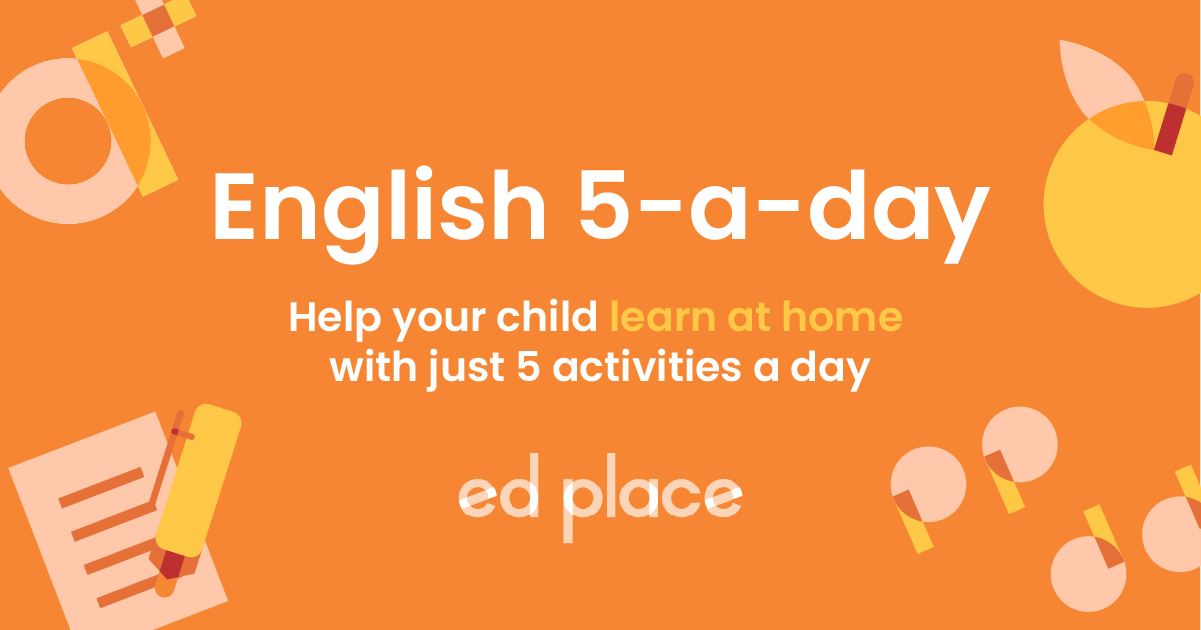
EdPlace's Y8 Home Learning English Lesson: Producing Paragraphs
Looking for short lessons to keep your child engaged and learning? Our experienced team of teachers have created English, maths and science lessons for the home, so your child can learn no matter where they are. And, as all activities are self-marked, you really can encourage your child to be an independent learner.
Get them started on the lesson below and then jump into our teacher-created activities to practice what they've learnt. We've recommended five to ensure they feel secure in their knowledge - 5-a-day helps keeps the learning loss at bay (or so we think!).
Are they keen to start practising straight away? Head to the bottom of the page to find the activities.
Now...onto the lesson!
Year 8: Consolidate!
No longer the newbies and not yet on the GCSE treadmill, Year 8 can feel like the in-betweener stage of secondary school life. While there may be just a little less scrutiny, it's the perfect time to get the basics right and prepare a secure foundation for the skills and knowledge that Key Stage 4 builds on.
In reality, GCSE English Language is a course that is constructed over eleven years of schooling, and with that, the assumptions about things students should already have mastered increases year on year. Students may enjoy the fresh start that Year 7 offers but can become demotivated when they feel trapped repeating errors in spelling, punctuation and grammar.
Revising, and putting into practice, some of the essentials can be a massive confidence boost and put students on a path to GCSE success. And of course, there are always the tricky bits about English – the irregular plurals, the pesky apostrophes, remembering to use the capital letters and full stops that fall by the wayside when trying to think of what to say… Fortunately, these are definitely skills that improve with repetition and focus.
Remember ‘Let’s eat Grandma’? The fatal omission of a comma that demonstrated how punctuation can be a life-saver? It drives home that point that punctuation, whatever we may think of it, is important!
After following this activity, your child should be able to:
1) Explain how paragraphs are used in both fiction and non-fiction writing to give structure and to set out direct speech
2) Identify different parts of a PEED/PEAD paragraph
3) Apply this process to their own writing
Step 1 - Learning the Lingo!
There are some pieces of terminology that we're going to use in this article, so it's important that both you and your child feel confident that they understand what these words mean.
The fronted adverbial (it's a fairly recent grammar favourite), a fancy label for sentences that start (fronted) with a word or phrase that describe the action in the sentence (adverbial):
for example - Suddenly, … Before the storm, … Fronted adverbials can be used to help as signposts in moving on the events of a story.
It will also help to become familiar with ‘PEED’ and ‘TiPToP’. Both are acronyms which serve as helpful reminders for organising ideas within paragraphs and whole texts. (We're going to cover this as we go, so do not worry if right now this makes little sense!)
Step 2 - A Page at a Glance
Paragraphs are how writers structure their work, whether it is an essay, a letter or a story. Just looking at a page tells you something about the way it is structured and therefore, possibly gives you a clue as to the type of content. Year 8s are often still getting to grips with this, so it is a helpful area to focus on and consolidate their understanding.
Step 3 - Paragraphs in Action
As mentioned the way that a page is structured can tell us a lot about the contents. There are some differences between the devices you will see used in fictional and factual pieces. Below there are 4 key things to look out for in the paragraphs you see around you, whether it be a newspaper article, a novel or an advertising leaflet.
1) Setting out direct speech
Let’s start with noticing that in fiction writing, a new line – indented - is used to show a change of speaker when setting out direct speech. A good way to draw attention to this is to read a chapter of a novel aloud together, changing the reader at each indentation.
2) Remind yourself of TiPToP paragraphs
This helps to show when it is appropriate to begin a new paragraph because you are introducing a change of, Time, Place, Topic or Person. You can try indicating a change by using a fronted adverbial (a word or a phrase used to start a sentence) to start a new paragraph, remembering to use a comma too:
In the morning, After they had cleared the table, At school
Using paragraphs in this way acts as signposts through a story, making the beginning, middle and end clear and direct, therefore, improving the structure.
3) Using paragraphing in essay writing
The structure shown through paragraphing is equally important when writing to discuss, argue or persuade. We start with an introduction, work through different points and finish with a conclusion.
4) We also have a structure within each paragraph:
-
We make a point (often called a topic sentence)
-
We give an example – use a quote or fact which supports the point
-
We explain our point further – try ‘This suggests’ as a sentence starter
-
We develop with additional information – try ‘Furthermore’ as a sentence starter
This is known as a PEED paragraph. Many students can grasp the Point and Example, but find it harder to Explain and Develop their ideas. Using the PEED process is a way of reminding students to go that bit further with their thoughts or analysis, and so scoop the extra marks.
Step 4 - Give it a go...
Before you set your child off on the 5 activities below, you may want to test both of your skills on one or all of the three tasks below?
A) Decide where a new line for a change of speaker should start in this dialogue:
The old man put the box down carefully and began to apologize. “I’m truly sorry, my Lord- I must have been closer than I thought-” “Get something to clear this mess up. Go on, before it soaks into the carpet!” The porter hurried out. Lord Asriel moved closer to the wardrobe and spoke in an undertone. “Since you’re in there you can make yourself useful.” “Yes, Uncle.” “Make a noise in there and I won’t help you. You’re on your own.”
(‘Northern Lights’, Philip Pullman)
B) Identify the different parts of this paragraph:
Phillip Pullman is one of the most successful authors of modern times. His series, known as ‘His Dark Materials’, has sold over 18 million copies since it was first published in 1995. This suggests that his books are becoming even more popular than the Harry Potter series. Furthermore, as well as the books being made into a movie and television series, Pullman is working on a second trilogy of further adventures that will attract yet another generation of readers to enjoy his books.
C) Use these notes to write a PEED style paragraph that answers this question:
Why is Northern Lights such a popular novel?
-
Readers enjoy stories with strong characters
-
Lyra is an example of a strong character because she goes on an adventure to rescue kidnapped children
-
This shows she is brave and determined making her a strong character
-
The novel has many other interesting and strong characters that helps to make it popular
Step 5 - Ready?
Using paragraphs effectively takes practice, but is a great skill to have mastered. Here are links to some other areas that help Year 8 students consolidate their use of essential basics of spelling and grammar.
All activities are created by teachers and automatically marked. Plus, with an EdPlace subscription, we can automatically progress your child at a level that's right for them. Sending you progress reports along the way so you can track and measure progress, together - brilliant!
Activity 1: Correct Common Spelling and Grammar Errors
Activity 2: Revise Your Spelling: Commonly Misspelt Words 1
Activity 3: Know Your Pre-fixes - dis
Activity 4: Revise the Past Tense
Activity 5: Use 'Less' and 'Fewer' Correctly
Keep going! Looking for more activities, different subjects or year groups?
Click the button below to view the EdPlace English, maths, science and 11+ activity library
All English, maths and science from Year 1 - GCSE
A) A new line to show a change of speaker:
‘The old man put the box down carefully and began to apologize.
“I’m truly sorry, my Lord- I must have been closer than I thought-”
“Get something to clear this mess up. Go on, before it soaks into the carpet!” The porter hurried out. Lord Asriel moved closer to the wardrobe and spoke in an undertone.
“Since you’re in there you can make yourself useful.”
“Yes, Uncle.”
“Make a noise in there and I won’t help you. You’re on your own.” ’
B) Identifying different parts of a PEED paragraph:
Point: Phillip Pullman is one of the most successful authors of modern times. (a topic sentence)
Example: His series, known as ‘His Dark Materials’, has sold over 18 million copies since it was first published in 1995. (includes dates / facts / quotes)
Explain: This suggests that his books are becoming even more popular than the Harry Potter series.
Develop: Furthermore, as well as the books being made into a movie and television series, Pullman is working on a second trilogy of further adventures that will attract yet another generation of readers to enjoy his books.
C) Why is Northern Lights such a popular novel?
‘Northern Lights’ is popular is because it has strong characters that readers enjoy. For example, Lyra is the main character who goes on a dangerous and exciting adventure to rescue kidnapped children. This shows that she is brave and determined, even though it is dangerous and readers support her. Furthermore, she brings other strong characters together, so it is like she builds an army around her to help her on her mission; this cast of strong characters is just one reason* for the novel’s popularity.
(*Note that the last line could link to the next paragraph that explains another reason and so build up an essay.)








